Last night, I was at a very posh restaurant with my aunt and uncle, both visiting from Japan. This restaurant had won praises from many newspaper food critics, bloggers, food-lovers, etc, and being the last of the Trinity of Bay Area Tasting Menus, I was really looking forward to a good meal.
...
Our tasting menu was just OK. It was actually several steps below the Dining Room at the Ritz and the French Laundry. In fact, I'd put this place below Koo. There was nothing really exciting to the menu - no ingredient or preparation worth remembering, no fun surprises, no ...spirit. The grains of salt were overly prominent, the combination of ingredients reminded me of recycled Asian-fusion from the 90s by Testuya Wakuda, but the worst offence? The cod was FISHY!
To anyone who mistakes that fishy smell for being fish-like... Fish is not supposed to be fishy! It's supposed to be sweet, juicy, and/or flakey. It's not even supposed to smell briney! The three Japanese at the table had a bite of the very small bite, looked at each other, and put our forks down. The Papa Bear was the only who continued to eat his share (and mine!). The dish had a deliciously grilled strawberry on the side, but the fishy juices even contaminated the strawberry!
It might be that we Japanese are particularly sensitive to that fishy smell because we eat so much raw fish. It signals mortal danger to the very core of our soul. Our ancesters developed their cooking methods to merge flavor with food safety to ensure safe consumption of fresh seafood. The wasabi, the soy sauce, the vinegar - all of those are not just to enhance the dining experience but also to protect ourselves from any seafood-related mishaps.
The strange thing was that the cod from last night was prepared to almost maximize the fishiness. With limited seasoning, the pungent odor was almost unbearable to me. It made me wonder if the Chef had confused that decaying smell of rotting fish with the essence of how fish is supposed to taste. Or maybe the recipe was made for a fresher counterpart fish? Regardless of the reason, that one fish ruined my image of the dish and that restaurant is forever written off from my book, no matter how many critics, bloggers, and gourmets sing praises.
Again, another reason I should have just stayed at home for dinner! ><
Showing posts with label Tasting Menus. Show all posts
Showing posts with label Tasting Menus. Show all posts
Monday, April 30, 2007
Wednesday, May 04, 2005
Spa and Kaiseki: the ultimate Japanese luxury - Part II
Looking back at these pictures makes me hungry and want to go back home for another onsen trip! I'm continuing tonight with more pictures and more description of our kaiseki meal at Benkei in the outskirts of Kyoto.
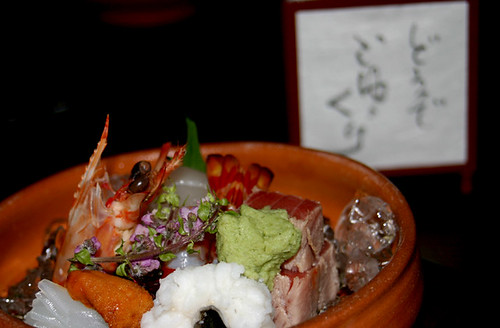
Our sashimi selection was plated on a bamboo mat, resting on a bed of ice. The amaebi (sweet raw shrimp) was surprisingly good. Too often, amaebi has that mushy, squishy, sticky texture, but this shrimp was so fresh and so clean with a natural sweetness and no stickiness. The consistency and texture was similar to lychee and I enjoyed it every bit. The rest of the sashimi plate (uni, squid, seared tuna) was not memorable, except the 'hamo', the shredded white fish you see in the front. Hamo is usually a summer fish, so I was a bit surprised by its early appearance. This is a technical piece, since the Chef has to chop the hamo bones into pieces while not damaging the skin underneath or totally butchering the meat through a process called 'honegiri' or bone-cutting. The hamo is then blanched and served cold. I love the texture of the hamo skin against the soft and delicate flesh.
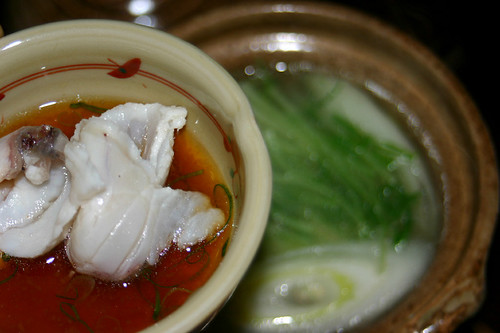
Speaking of blanching, that is exactly what shabu shabu is, and did I tell you I love it? And shabu shabu doesn't necessarily have to be done with beef. A common alternative is snapper or tai, and tai-shabu is served in many upscale Japanese eateries. In typical ryokan fashion, we each got individual clay pots and candle-based pot heaters for our tai shabu course. This was yummy, yummy, yummy. We waited patiently until the broth inside was boiling and then added our vegetables to cook. When the pot came back to a boil again, we dipped our snapper sashimi slices in there just until it was white on the outside, heated yet raw in the inside. The hot surroundings with the melt-in-your-mouth soft sweetness of the snapper was highlighted by the tangy ponzu sauce.
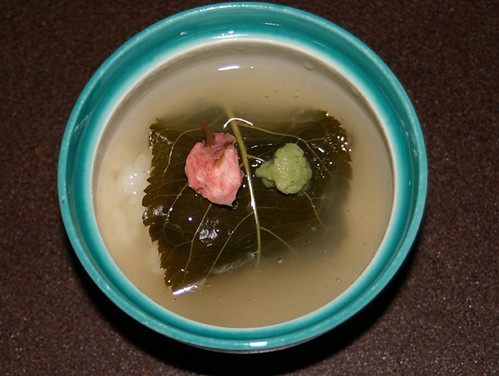
Although the tai shabu was delicious, my number one favorite dish from my dinner at Benkei was this unagi sakuramochi-style. Just like a sakuramochi, inside the fragrant cherry leaf was a ball of mochi-gome, the super sticky rice that the Chinese and the Vietnamese in the Bay Area call 'Sweet Rice'. This is somewhat misleading since the rice is not any sweeter than regular Japanese rice. This dish was not sweet either, as my sakuramochi title might indicate. This was a warm, savory dish with a nourishing quality beyond description. There was a slice of unagi between the cherry leaf and the rice, adding a plesant richness to the dish. The sauce was a thick, rich fish-based dashi and the perfect accompaniment to the rice ball. The saltiness of the cherry leaf worked so well with the warm and comforting broth.
We had an interesting take on the common 'sunomono' (vinegered item) dish, where we were served sashimi with a dipping sauce of vinegar and mirin (super-sweet sake, used only for cooking). I had never thought about sunomono that way and I appreciated the creativity very much. The idea was executed very well, and the mirin-vinegar was wonderful with the clam sashimi. I think I will do a variation of this at a sushi dinner party I am planning next (after this weekend's Kyoto Feast).
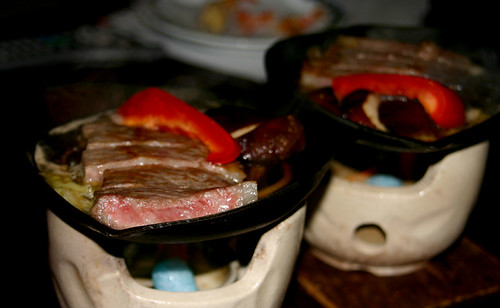
The final dish of Benkei and my kaiseki posts is a Japanese beef steak, cooked and kept warm by the same individual heaters that were once holding our tai shabu clay pot. Our server came by about three times to clear empty plates and bring us new courses, and in one of her visits, she took our tai shabu pots away and brought us these steaks. She wasn't sure what kind of wagyu it was, but it sure was tender and juicy, just as wagyu is supposed to be!
We finished the meal off with a soup and rice. I think we had dessert, but I was SOOOOO sleepy, I don't remember it. Half dead from jet-lag and a bad case of some nasty virus, I didn't even make it to the post-dinner soak that I was looking so forward to enjoying. I rolled over after dinner and relaxed in the second room while the ryokan ladies came and set up our traditional Japanese futons in the other room. And within 30 min of my epicurean debauchery, I was blissfully asleep, wondering how I managed to be so fortunate - a tummy full of fabulous food and resting so peacefully, surrounded by wonderful scents of tatami and wood.
I woke up promptly at 6 AM the next day for my soak and yoga in the outdoor bath again. I sure am a lucky one!

Our sashimi selection was plated on a bamboo mat, resting on a bed of ice. The amaebi (sweet raw shrimp) was surprisingly good. Too often, amaebi has that mushy, squishy, sticky texture, but this shrimp was so fresh and so clean with a natural sweetness and no stickiness. The consistency and texture was similar to lychee and I enjoyed it every bit. The rest of the sashimi plate (uni, squid, seared tuna) was not memorable, except the 'hamo', the shredded white fish you see in the front. Hamo is usually a summer fish, so I was a bit surprised by its early appearance. This is a technical piece, since the Chef has to chop the hamo bones into pieces while not damaging the skin underneath or totally butchering the meat through a process called 'honegiri' or bone-cutting. The hamo is then blanched and served cold. I love the texture of the hamo skin against the soft and delicate flesh.

Speaking of blanching, that is exactly what shabu shabu is, and did I tell you I love it? And shabu shabu doesn't necessarily have to be done with beef. A common alternative is snapper or tai, and tai-shabu is served in many upscale Japanese eateries. In typical ryokan fashion, we each got individual clay pots and candle-based pot heaters for our tai shabu course. This was yummy, yummy, yummy. We waited patiently until the broth inside was boiling and then added our vegetables to cook. When the pot came back to a boil again, we dipped our snapper sashimi slices in there just until it was white on the outside, heated yet raw in the inside. The hot surroundings with the melt-in-your-mouth soft sweetness of the snapper was highlighted by the tangy ponzu sauce.

Although the tai shabu was delicious, my number one favorite dish from my dinner at Benkei was this unagi sakuramochi-style. Just like a sakuramochi, inside the fragrant cherry leaf was a ball of mochi-gome, the super sticky rice that the Chinese and the Vietnamese in the Bay Area call 'Sweet Rice'. This is somewhat misleading since the rice is not any sweeter than regular Japanese rice. This dish was not sweet either, as my sakuramochi title might indicate. This was a warm, savory dish with a nourishing quality beyond description. There was a slice of unagi between the cherry leaf and the rice, adding a plesant richness to the dish. The sauce was a thick, rich fish-based dashi and the perfect accompaniment to the rice ball. The saltiness of the cherry leaf worked so well with the warm and comforting broth.
We had an interesting take on the common 'sunomono' (vinegered item) dish, where we were served sashimi with a dipping sauce of vinegar and mirin (super-sweet sake, used only for cooking). I had never thought about sunomono that way and I appreciated the creativity very much. The idea was executed very well, and the mirin-vinegar was wonderful with the clam sashimi. I think I will do a variation of this at a sushi dinner party I am planning next (after this weekend's Kyoto Feast).

The final dish of Benkei and my kaiseki posts is a Japanese beef steak, cooked and kept warm by the same individual heaters that were once holding our tai shabu clay pot. Our server came by about three times to clear empty plates and bring us new courses, and in one of her visits, she took our tai shabu pots away and brought us these steaks. She wasn't sure what kind of wagyu it was, but it sure was tender and juicy, just as wagyu is supposed to be!
We finished the meal off with a soup and rice. I think we had dessert, but I was SOOOOO sleepy, I don't remember it. Half dead from jet-lag and a bad case of some nasty virus, I didn't even make it to the post-dinner soak that I was looking so forward to enjoying. I rolled over after dinner and relaxed in the second room while the ryokan ladies came and set up our traditional Japanese futons in the other room. And within 30 min of my epicurean debauchery, I was blissfully asleep, wondering how I managed to be so fortunate - a tummy full of fabulous food and resting so peacefully, surrounded by wonderful scents of tatami and wood.
I woke up promptly at 6 AM the next day for my soak and yoga in the outdoor bath again. I sure am a lucky one!
Tuesday, May 03, 2005
Spa and Kaiseki: the ultimate Japanese luxury - Part I
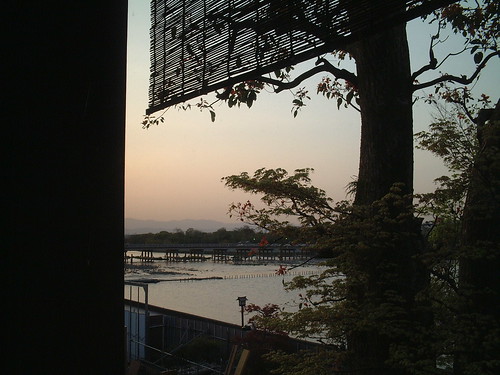
Thanks, Mogurin, for letting me use this beautiful picture of the view from our ryokan!
A ryokan is a traditional Japanese inn with tatami rooms and complimentary yukata (pajama-like versions of kimono). Ryokans often boast gorgeous hot spas from nearby hot springs (onsen) and kaiseki dinners served in the comfort of your own room. As a child growing up in Japan, my family frequently vacationed at family-friendly onsen ryokans, where the adults spent countless hours bathing and soaking while the kids played in the arcades or at the ping pong tables.
As I grew up, I cared less for the arcades and more for the quiet baths and terrific cuisine. During my recent trip, my Mama arranged for us to stay at a beautiful onsen ryokan, known for its sophisticated Kyoto Kaiseki. This was high-end onsen vacationing, far removed from the onsen trips of my childhood. It highlighted my grown-up appreciation for quiet and peaceful calmness. And I appreciated my Mama's thoughts so much for selecting somewhere that fit my current (grown-up) state of mind - who I am right now - so perfectly.
Benkei, our ryokan, is located in Arashiyama, a district within the Greater Kyoto region. Arashiyama is the spot where nobles living in Kyoto during the Heian period went to vacation, which sounds funny now, seeing that it seems like Arashiyama is within the Kyoto city limits. It is famous for its cherry blossoms and claims to be the spot where the sakuramochi was first created. Arashiyama is also has a hot spring source, and its weakly alkaline water is supposed to help with muscle soreness, skin clarification, and fatigue. I think any fatigue will be gone, regardless of the hot spring quality, after the pampering and relaxing an onsen ryokan like Benkei offers!
Benkei is relatively small with only 15 rooms total and many scenic bathing options (two per sex and one 'for rent' by couples/families/individuals). I prefer small ryokans for many reasons. The first of them is the fact that I don't really like to bathe with other people, and the spas at small ryokan at off hours are empty. I was the only one in the ladies' outdoor bath both times I went for a long soak - and a giant bath tub all to myself is luxury at its best. I even did some yoga in between my soaks! Outside! Completely naked! It was so liberating. By the way, these baths are very well protected and no one can peak or even worse, sneak in, although I've seen footage of monkeys coming down from the mountains in the Northern onsens for a dip along side their distant human cousins.
The other highlight was dinner. My Mama chose Benkei for our Kyoto stay, since the food was supposed to be some of the best traditional kaiseki meals at a ryokan. And I have to agree, it was quite stellar. Dinner at ryokans are served in your room, and you get to lounge around in your PJ Kimono (yukata) with wet hair from the onsen soak and lay down in between courses. It's super-relaxed and it was exactly what I needed, since I was coming down with some terrible viral sinus congestion. And since I overloaded you with more traditional food presentation with my two Hyotei posts, I'll post some of my more adventurous food photos!
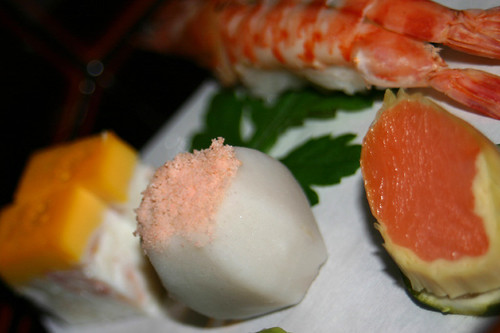
As with all typical kaiseki meals, we started with a bunch of small bites, but unlike a super-traditional kaiseki course like the one at Hyotei, they served us a bunch of courses at the same time. Being a ryokan, the focus is more on relaxing and less on super traditional service. The Sakizuke and Hassun (equivalent of appetizer courses) were served all at once. Here you see a shrimp sushi, two-layered crab 'cake', a yam-like potato, and salmon wrapped in yuba (counter-clockwise from the shrimp). There was a home-made green bean tofu with uni as well on the side.
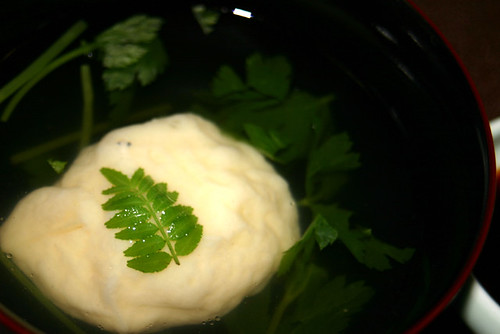
Then, they brought us the sakisuimono, the first of the soups. This was a clear soup with a huge shirauo (small fish - remember my tempura post?) cake that was really delicate and tenderly soft. Seasonality is so big in Japanese cuisine that the same ingredients are used in many of these restaurants. The fun part is seeing how differently they are presented from restaurant to restaurant, which I suppose is the joy of dining out anywhere! The green leaf you see on top of the fish cake is different from the green leaves in the soup. The one on top is Kinome, which has a very distinct scent and is ubiqutious in Kyoto cuisine. I LOVE it. It's very fragrant and smells like nothing else - gotta go to Kyoto to try it! The greens inside the soup is just mitsuba, which is a bitter leaf vegetable, available in some of the more exotic grocery stores around here in the Bay Area.
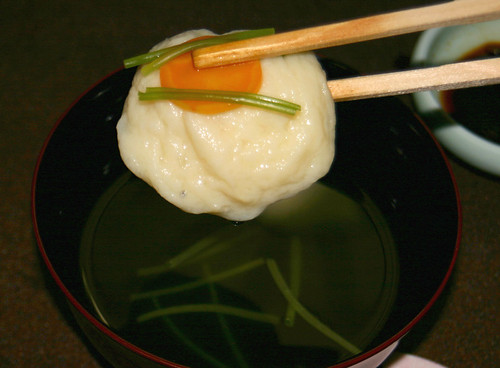
It is bad manners in Japan to pick up more than one object at a time with your chopsticks, but the color contrasts between the clear broth on the bottom, the orange carrots, the green mitsuba stalks, and the creamy fish cake was so pretty, I had to snap a shot.
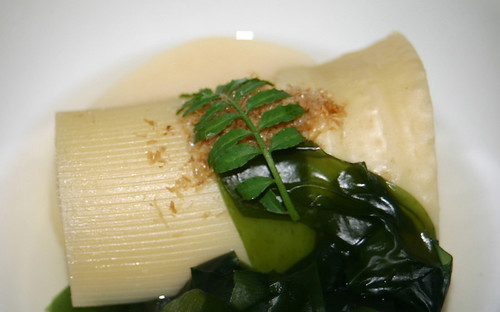
Yes, takenoko again!!! And it was very good too. Maybe not quite as 'clean' tasting as Hyotei, but to compare anything to Hyotei is not fair. This dish had a strong bonito backbone, and I really enjoyed it. Again, you see the kinome here, and it definitely added another aspect to the dish. So small, yet so critical to creating that Kyoto flavor...
Well, looks like I've used up my blog-time today, so I'll have to split this post in two too! I spent too much time yapping about the onsen aspect, I didn't get through the food! Oh well. Come back tomorrow for more wagyu, snapper shabu shabu, and my favorite dish of the night: unagi sakura mochi style!
Click here for Part II!
Monday, May 02, 2005
Hyotei: the spirit of kaiseki dining - Part II
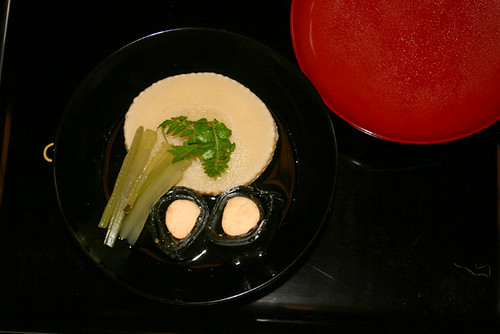
Part II of my Hyotei post begins with my favorite Spring vegetable: the bamboo shoot. Bamboo shoots are the symbol of Spring in Japanese cooking and revered for their soft yet crunchy dichotomy. It is said that the window of deliciousness is much smaller for bamboo shoots than for any kind of fish, and the best of the best bamboo shoots are those dug up in the early morning of the same day. This aspect of intense timeliness appeals very much to the spirit of kaiseki cuisine, and these tenderly crunchy bamboo shoots have been infusing Spring breeze into kaiseki dishes for a long time.
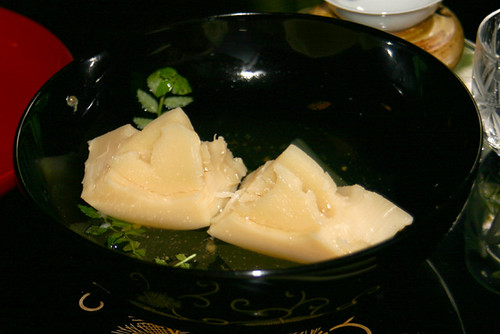
At Hyotei, these bamboo shoots were slowly cooked in delicate dashi. Cooking something white with dashi requires mastering of dashi itself, since the Chef must create seasoning that does not stain the bamboo shoots themselves. The cream-colored purity of the bamboo shoots you see here is evidence of the immense skill this kitchen contains.
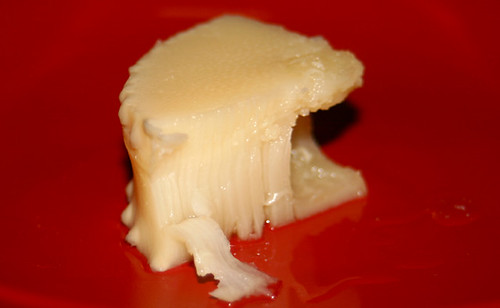
I was so overwhelmed at how soft yet crunchy these bamboo shoots were. They broke apart with my chopsticks along the fibers. The fibers were so well-infused with dashi that they separated with ease. But they maintained their pleasurable texture so well. This was Spring at its best. If you have never had bamboo shoots that are neither pickled nor pre-boiled, a trip to Kyoto in the Spring is in order...
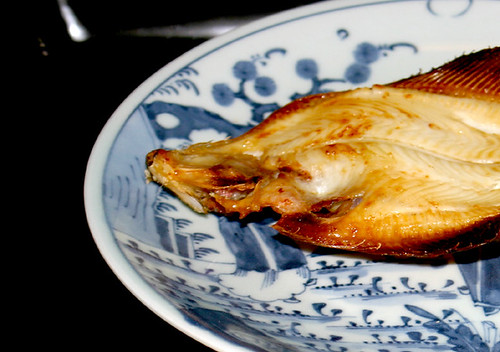
The next and final 'meat' course was house-dried fish. For the life of me, I can't remember what the fish was, but this dish is called, "Ichiya boshi" or "One night dried" fish. Unlike traditional dried fish, the reason for drying is not preservation but rather to increase flavor and texture. Drying the fish overnight eliminated excess water from the meat and concentrated the sweetness of the flesh. It was grilled to perfection and I enjoyed the smoky aroma accompaniment to the sweet fish.
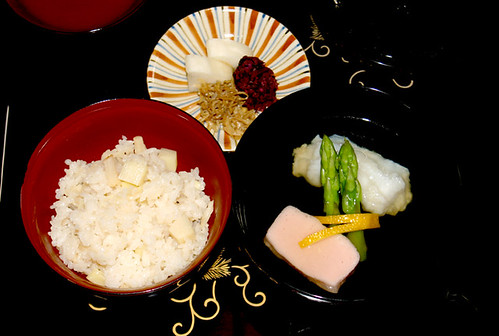
Rice and soup signaled the end of the savory dishes. Although stuffed beyond belief, all three of us finished the scallop rice and clear soup. None of us even a grain of rice left on our plates.
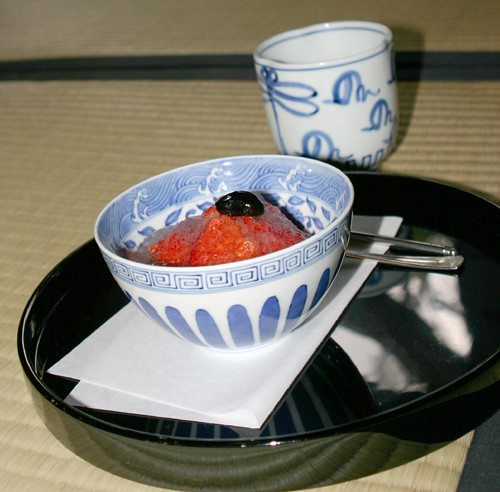
Dessert was a two-course affair, starting with fruits. This dish symbolizes why Hyotei continues to be the pinnacle of Japanese cuisine. Rather than being complacent with its traditional cuisine, the kitchen here takes adventures, incorporating new ideas and concepts from other culinary trends. Here, we see Strawberries with Gelee, a very refreshing touch after the multi-, multi-course meal we had enjoyed. As you see, they took away our elevated tray-tables for dessert. We enjoyed our first course dessert on trays of their own.
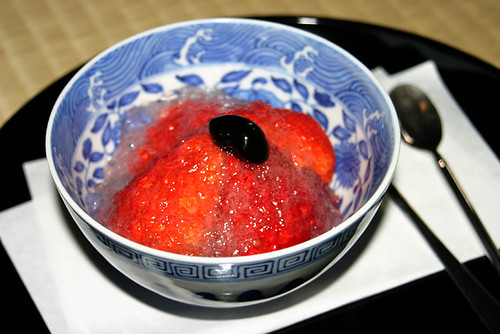
Concluding the affair (second dessert dish) was a traditional tea ceremony set-up, in which we were served a sweet treat, followed by green tea. I am not going to share the pictures of these here, since I am planning on doing a special green tea post some time soon!
In retrospect, the meal at Hyotei was nothing short of perfect. Everything was perfect. From the timing of my tea being refilled to the temperature of the soups, everything was calculated to an amazing exactness, and they made it seem so effortless. Our server was a charming lady with the warmest smile, and she made us feel totally at ease and comfortable. There was absolutely nothing pretentious to Hyotei and we were welcomed like old friends. Our server even let us go take a peak at their oldest dining room after our meal, which boasts a beautiful view of their meticulously maintained garden.
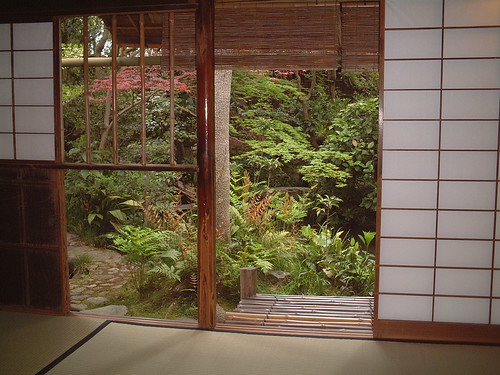
Hyotei, literally translates to Gord Eatery, and I have no idea what the reason behind their name is. But after eating there, my interpretation is that one is hidden away from reality in the comfortable Hyotei World, as if escaping inside a gord. Next time I am in Kyoto, I will definitely be stopping by Hyotei again.
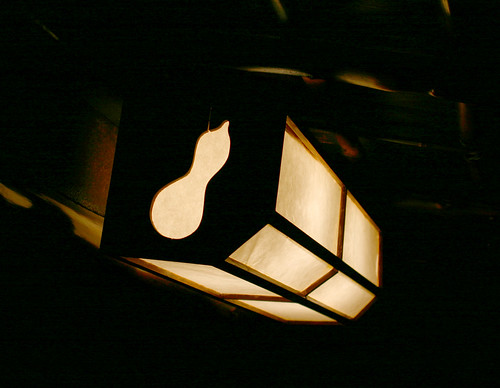
Sunday, May 01, 2005
Hyotei: the spirit of kaiseki dining - Part I
The biggest reason for my wanting to go visit Kyoto was not the famous Golden Pavillion or the Zen garden at Ryoanji. It was to visit Hyotei, a 350 yr old eatery in Kyoto, regarded by many to be the epicenter of Kyoto cuisine, known as Kyo-kaiseki.
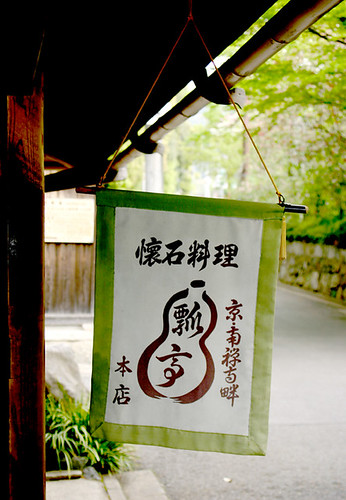
Kaiseki meals are multicourse affairs, where the diner is presented with seasonal dishes cooked with utmost attention to detail. Everything is orchestrated to provide the diner with the best possible experience, starting with the first cup of tea brewed to be at the perfect temperature to the dishware used to serve each course. Often, dishes are served in bowls with the chef's intentions closed tightly inside under a lid - diners get the full effect upon lifting the lid and being greeted by wonderful aromas wafting up with the steam. Kaiseki cuisine is true evidence that Japanese food is so much more than raw fish and sushi. Although sashimi often plays a part in the kaiseki course, it is a small component of the wonderful ensemble.
Hyotei started out as a tea stop for the pilgrims visiting the near-by Nanzenji temple and became an eatery in August, 1837. A meal at Hyotei is like traveling back in time and enjoying a serene meal in an environment away from all the hustle and bustle. It is nourishing, warm, and rejuvenating - all aspects of what a warm 'motenashi' or 'welcoming' should feel like.
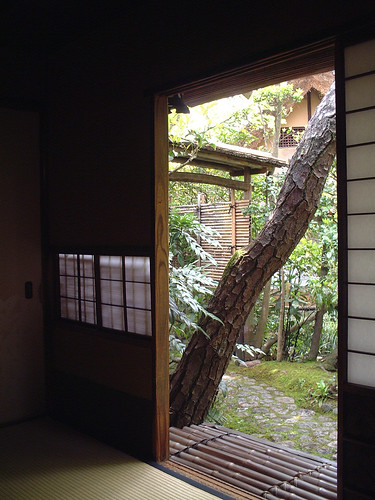
There are only five dining rooms associated with the main Hyotei building, and each party occupies one room. Each of these rooms used to be tea rooms with traditional tea ceremony service back in the day when Hyotei was a tea house. We were led to a cozy, comfortable space for our meal.
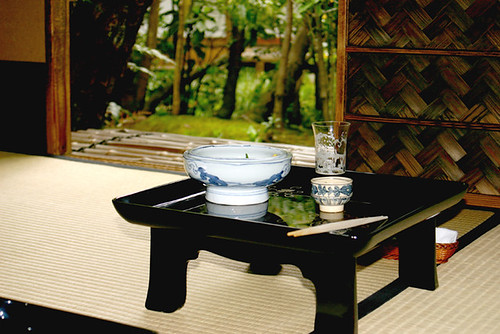
As with many traditional Japanese eateries, we sat on tatami floors with individual 'tables' as you see here. The table/trays are works of lacquer art, and they give a smooth, seductive feel as they reflect off the gorgeous outside green onto its deep black surface. A point on Japanese manners: once you use your chopsticks, the proper way to rest them on these trays is to put the side your mouth touches off the edge...
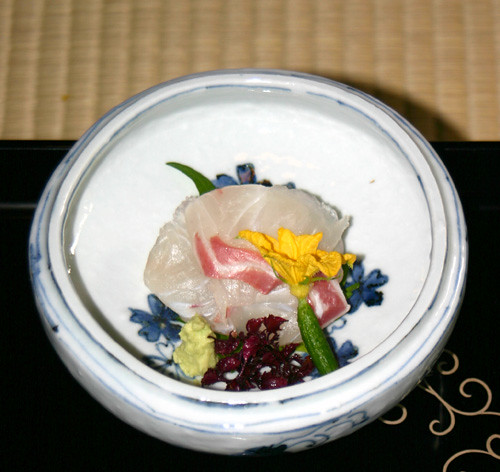
The first set of dishes from this meal was a trio of snapper sashimi, snapper shirako (epididymus - warning: click only if you really want to know!!), and lightly fried soramame beans. My Mama and I were both taken back by how smooth the snapper sashimi was. You could almost taste the sharpness of the knife used here, and the sweetness of the meat was accentuated by the flawless clean cut. This plate of sashimi reminded me that preparing sashimi requires culinary mastery and that sashimi, despite its unheated state, is actually 'cooked' food after all.
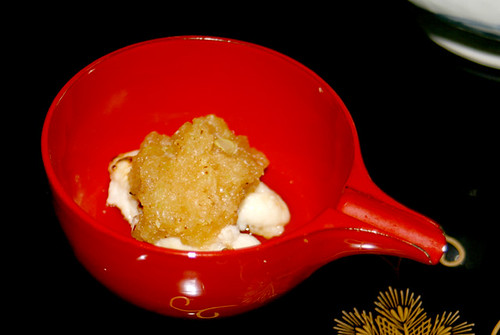
The snapper shirako was lightly grilled and topped with grated daikon and ponzu. The almost liquid shirako melted in my mouth as I tried to enjoy the flavors without thinking about what I was eating. Shirako is a revered delicacy in Japan that I just can't grow to appreciate. I've been trying to block out my prejudices and really taste them for what they are, but knowing what it is makes me cringe everytime... This dish was visually attractive - the delicate white of the shirako, the bright red lacquer of the bowl, and the stark contrasting black lacquer tray was breath-taking.
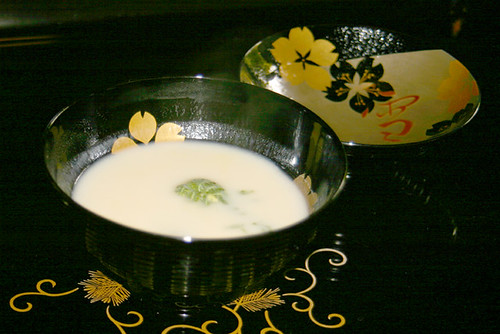
Next up was a simply stunning soup. It was a white miso soup with the most nourishing, motherly warmth. This was simply divine. All three of us inhaled the aroma and stopped talking. For a moment, we all sat in a total state of relaxation, as the warm, sweetness of the miso traveled our bodies. White miso is a Kyoto specialty, and a properly preapred white miso soup is nothing like the miso soups we get here in the US. This soup had an almost milky richness to it with a subtle sweetness. Inside was a mountain plant, the harbringer of Spring that I discussed in an earlier post. It is very rare that I become speechless about food, but this bowl of soup was so wonderful, I was left in speechless awe. I was so overwhelmed by this miso soup that I begged them for their white miso distributor and brought some back with me... (And yes, if you are nice to me, I will try to make you my version of this wonderful soup...) The presentation was equally stunning, and the soup was served in a black lacqur bowl with a lid that opened up to show the gorgeous golden artwork with the Japanese character for 'snow', pictured here.
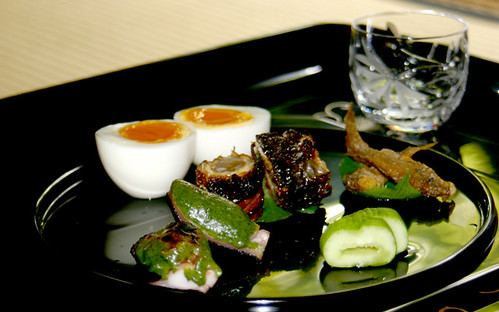
The next dish was an ensemble of various bites. These were all wonderful, but the highlight of this plate was the boiled egg. Known as the Hyotei Tamago (Egg), it is a perfectly boiled egg with a rich, luscious near-liquid center, surrounded by solid egg white. This egg has been served here since the time when most people were still eating raw eggs as the height of culinary sophistication, which is still evident as the spirit Hyotei continues to live by today. What mystifies me is how they are able to slice this near-liquid center in half without tainting the white part with the egg yolk.
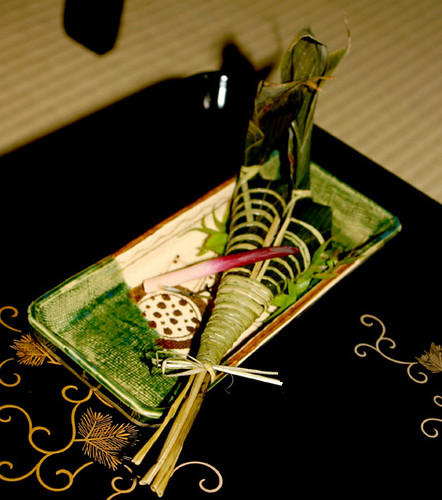
We were then presented with a fun diversion of unwrapping our sasa-zushi (bamboo sushi). Carefully wrapped in bamboo leaves, these rolls gave off a very pleasant green bamboo leaf scent, refreshing us at the mid-way point of our meal.
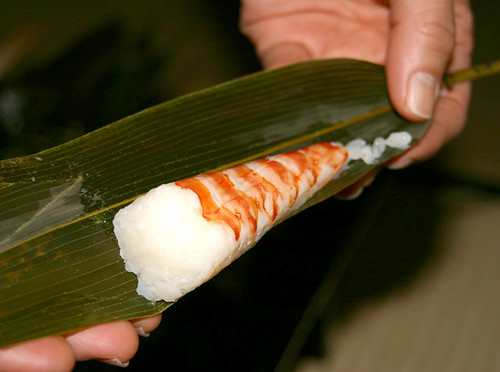
Inside was a plump and youthful shrimp sushi or a mature and elegant sophisticated snapper sushi. Both offered totally different textures and flavors, and the combination was just as fun as the process of unwrapping the bamboo packages.
That's going to be the end of my posts today, since I have five more courses to describe to you, as well as stories about our wonderful server who told me the miso distributor and the markets I can go find it, along with a sneak peak at Hyotei's oldest dining room! Click here for more Hyotei debaucherizing!

Kaiseki meals are multicourse affairs, where the diner is presented with seasonal dishes cooked with utmost attention to detail. Everything is orchestrated to provide the diner with the best possible experience, starting with the first cup of tea brewed to be at the perfect temperature to the dishware used to serve each course. Often, dishes are served in bowls with the chef's intentions closed tightly inside under a lid - diners get the full effect upon lifting the lid and being greeted by wonderful aromas wafting up with the steam. Kaiseki cuisine is true evidence that Japanese food is so much more than raw fish and sushi. Although sashimi often plays a part in the kaiseki course, it is a small component of the wonderful ensemble.
Hyotei started out as a tea stop for the pilgrims visiting the near-by Nanzenji temple and became an eatery in August, 1837. A meal at Hyotei is like traveling back in time and enjoying a serene meal in an environment away from all the hustle and bustle. It is nourishing, warm, and rejuvenating - all aspects of what a warm 'motenashi' or 'welcoming' should feel like.

There are only five dining rooms associated with the main Hyotei building, and each party occupies one room. Each of these rooms used to be tea rooms with traditional tea ceremony service back in the day when Hyotei was a tea house. We were led to a cozy, comfortable space for our meal.

As with many traditional Japanese eateries, we sat on tatami floors with individual 'tables' as you see here. The table/trays are works of lacquer art, and they give a smooth, seductive feel as they reflect off the gorgeous outside green onto its deep black surface. A point on Japanese manners: once you use your chopsticks, the proper way to rest them on these trays is to put the side your mouth touches off the edge...

The first set of dishes from this meal was a trio of snapper sashimi, snapper shirako (epididymus - warning: click only if you really want to know!!), and lightly fried soramame beans. My Mama and I were both taken back by how smooth the snapper sashimi was. You could almost taste the sharpness of the knife used here, and the sweetness of the meat was accentuated by the flawless clean cut. This plate of sashimi reminded me that preparing sashimi requires culinary mastery and that sashimi, despite its unheated state, is actually 'cooked' food after all.

The snapper shirako was lightly grilled and topped with grated daikon and ponzu. The almost liquid shirako melted in my mouth as I tried to enjoy the flavors without thinking about what I was eating. Shirako is a revered delicacy in Japan that I just can't grow to appreciate. I've been trying to block out my prejudices and really taste them for what they are, but knowing what it is makes me cringe everytime... This dish was visually attractive - the delicate white of the shirako, the bright red lacquer of the bowl, and the stark contrasting black lacquer tray was breath-taking.

Next up was a simply stunning soup. It was a white miso soup with the most nourishing, motherly warmth. This was simply divine. All three of us inhaled the aroma and stopped talking. For a moment, we all sat in a total state of relaxation, as the warm, sweetness of the miso traveled our bodies. White miso is a Kyoto specialty, and a properly preapred white miso soup is nothing like the miso soups we get here in the US. This soup had an almost milky richness to it with a subtle sweetness. Inside was a mountain plant, the harbringer of Spring that I discussed in an earlier post. It is very rare that I become speechless about food, but this bowl of soup was so wonderful, I was left in speechless awe. I was so overwhelmed by this miso soup that I begged them for their white miso distributor and brought some back with me... (And yes, if you are nice to me, I will try to make you my version of this wonderful soup...) The presentation was equally stunning, and the soup was served in a black lacqur bowl with a lid that opened up to show the gorgeous golden artwork with the Japanese character for 'snow', pictured here.

The next dish was an ensemble of various bites. These were all wonderful, but the highlight of this plate was the boiled egg. Known as the Hyotei Tamago (Egg), it is a perfectly boiled egg with a rich, luscious near-liquid center, surrounded by solid egg white. This egg has been served here since the time when most people were still eating raw eggs as the height of culinary sophistication, which is still evident as the spirit Hyotei continues to live by today. What mystifies me is how they are able to slice this near-liquid center in half without tainting the white part with the egg yolk.

We were then presented with a fun diversion of unwrapping our sasa-zushi (bamboo sushi). Carefully wrapped in bamboo leaves, these rolls gave off a very pleasant green bamboo leaf scent, refreshing us at the mid-way point of our meal.

Inside was a plump and youthful shrimp sushi or a mature and elegant sophisticated snapper sushi. Both offered totally different textures and flavors, and the combination was just as fun as the process of unwrapping the bamboo packages.
That's going to be the end of my posts today, since I have five more courses to describe to you, as well as stories about our wonderful server who told me the miso distributor and the markets I can go find it, along with a sneak peak at Hyotei's oldest dining room! Click here for more Hyotei debaucherizing!
Subscribe to:
Posts (Atom)